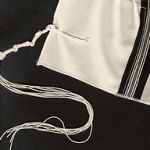The spies needed tzitzit – Sh’lach L’cha
 If the spies had worn tzitzit they would not have gone wrong!
If the spies had worn tzitzit they would not have gone wrong!
Surely that is the lesson to be learned from linking the beginning and the end of the sidra.
The beginning is the story of the reconnaissance of the land; the end is the passage we call the third paragraph of the Shema, which tells us to place fringes, tzitzit, on the corners of our garments.
As Rashi points out, both stories use the same crucial verb. The first says the twelve representatives of the people went la-tur et ha-aretz (Num. 13); the second, v’lo taturu acharei l’vav’chem v’acharei eineichem (Num. 15:39).
La-tur, taturu – both come from a root that means to search out.
The Shema tells us not to search out and follow what our heart suggests and our eyes see. Now surely that does not mean that we should try and stop our heart and eyes working. Both are Divinely given blessings and through them so much human achievement has been and is possible.
But the heart and eyes are not the only guides to human conduct; there is also the mind and the soul.
What went wrong with the spies was that mind and soul did not temper heart and eyes.
They followed their instinct and forgot to reason out that if God said the land was to be theirs, He could be relied upon; they failed to heed their soul which said they could and should have faith in God.
So the Shema tells us to wear fringes on the corners of garments to remind us that in every corner of life we should consult God’s will before acting.



